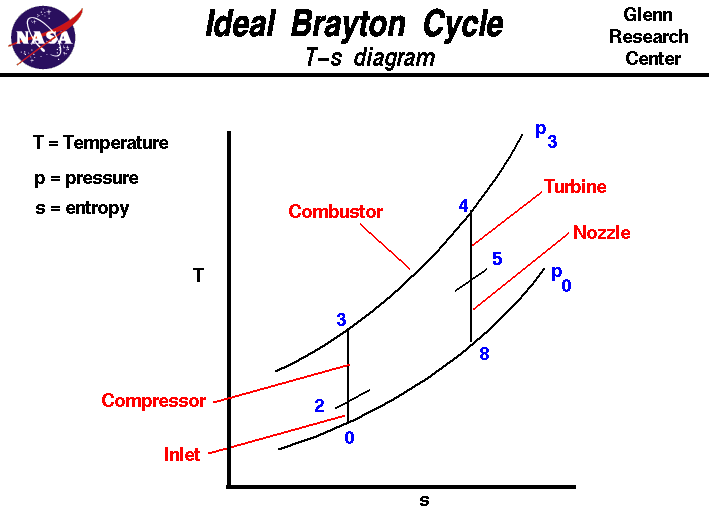oggers, Slippery_Pete,
do you really think that QJB (or anyone else having the same question) will have the patience of reading all your duet and will try to find an answer in it ?
@QJB,
MathFox has actually written a complete and concise answer in post #30.
If you want to go further and understand or visualize the formula, you'll have to get somewhat familiar with T-s diagrams (temperature-entropy).
The theoritical diagram for the Brayton cycle (turbines) is underneath.
These diagrams are easy to read because they hold together the heat that enters the engine, the (lost) heat that exits the device, and the work produced.
- The heat that enters the device is depicted by all the area that is underneath the upper line(s) of the cycle, descending down up to the axis. Hereunder, it is all the area that is beneath the curved line 3-4.
- The lost heat that exits the device is depicted by all the area that is underneath the lower line(s) of the cycle, descending down up to the axis. Hereunder, it is all the area that is beneath the curved line 8-0.
- The work that can be produced (theoritically) is the difference of the two, that is, the area within the cycle 0-3-4-8-0.
- The efficiency of the cycle (theoritical) is the ratio of the inner surface divided by the whole surface underneath the line 3-4.
The points of the upper curved line 3-4 are at a constant pressure ; the pressure of the combustion chamber (p3).
The points of the lower curved line are at a constant pressure ; the external atmospheric pressure (p0).
The point 0 is at the entry of the inlet and the point 8 is somewhere in the exhaust flow behind the nozzle. The linking from 8 to 0 represents an hypothetical closure of the cycle by dragging the exhaust air from the nozzle to the inlet whilst letting it cool down at constant pressure up to the ambiant temperature.
It is clear that the lower curve is constrained by the value of the atmospheric pressure (p0).
It is also clear that increasing the combustion chamber pressure (p3) will push the line 3-4 higher on a parallel curve line and will increase the ratio of the inner surface (work) to the area underneath 3-4 (input heat), and thus will increase the efficiency of the cycle.
Luc

The image is from the
www.grc.nasa.gov web page :
Turbine Engine Thermodynamic Cycle - Brayton Cycle